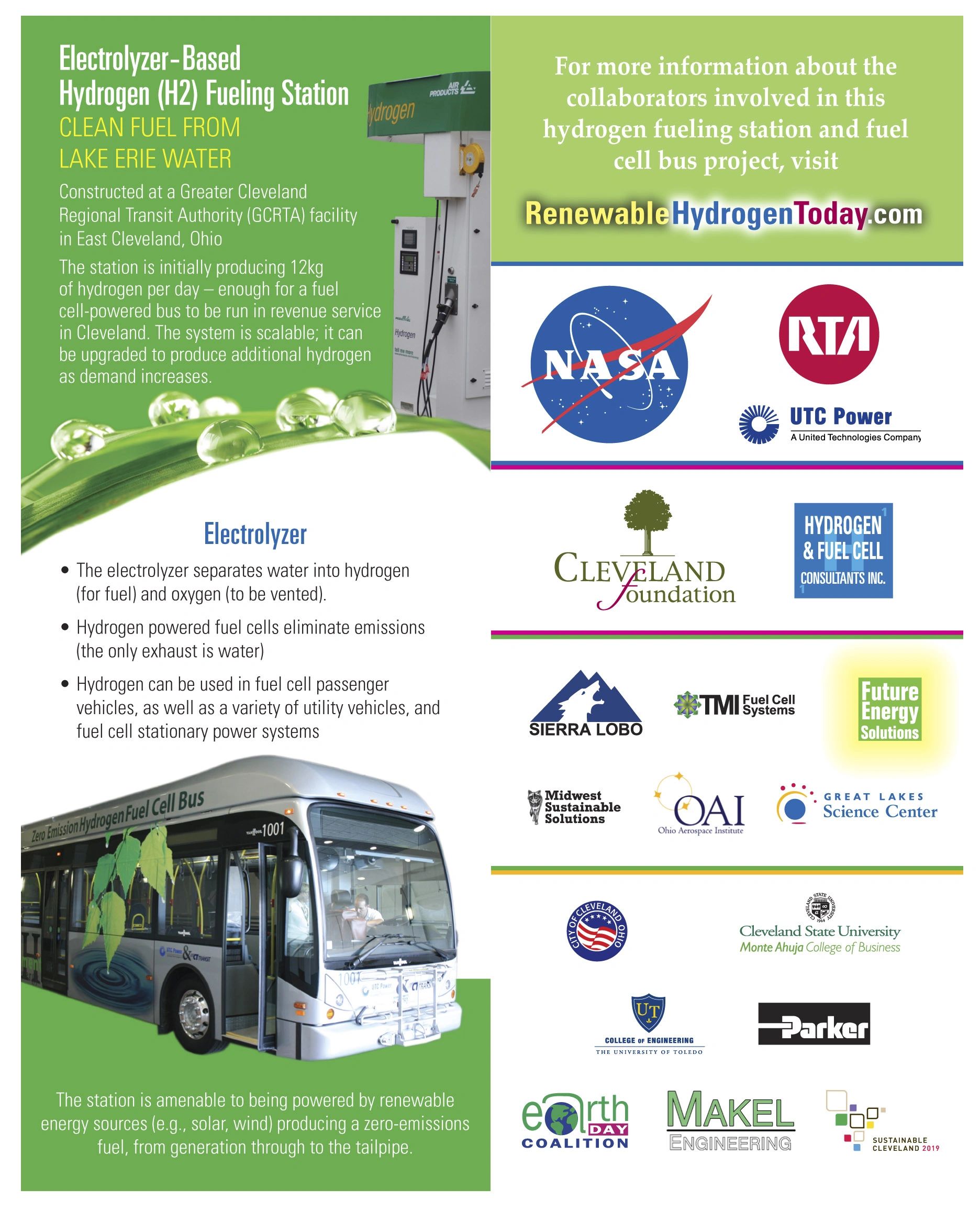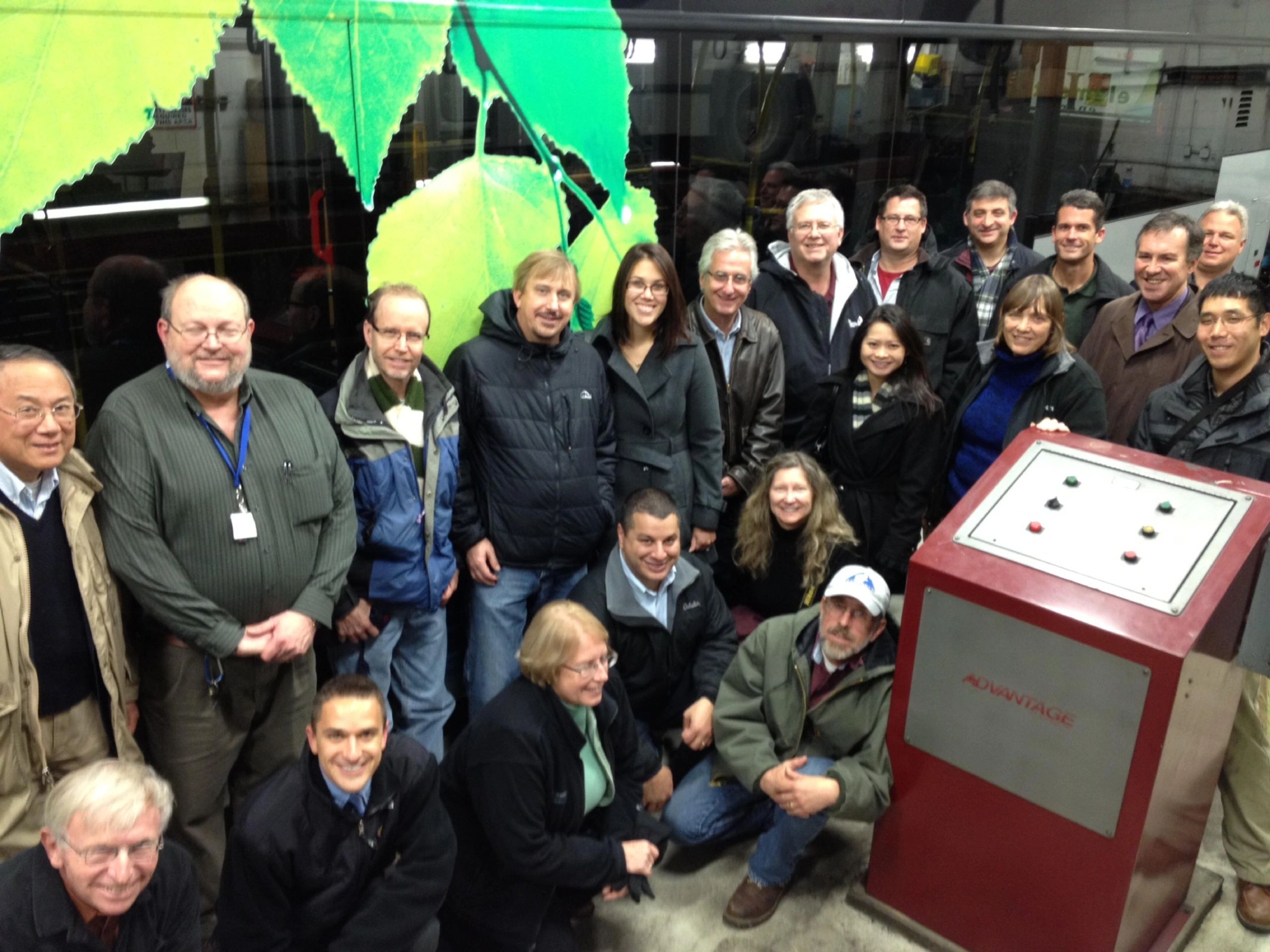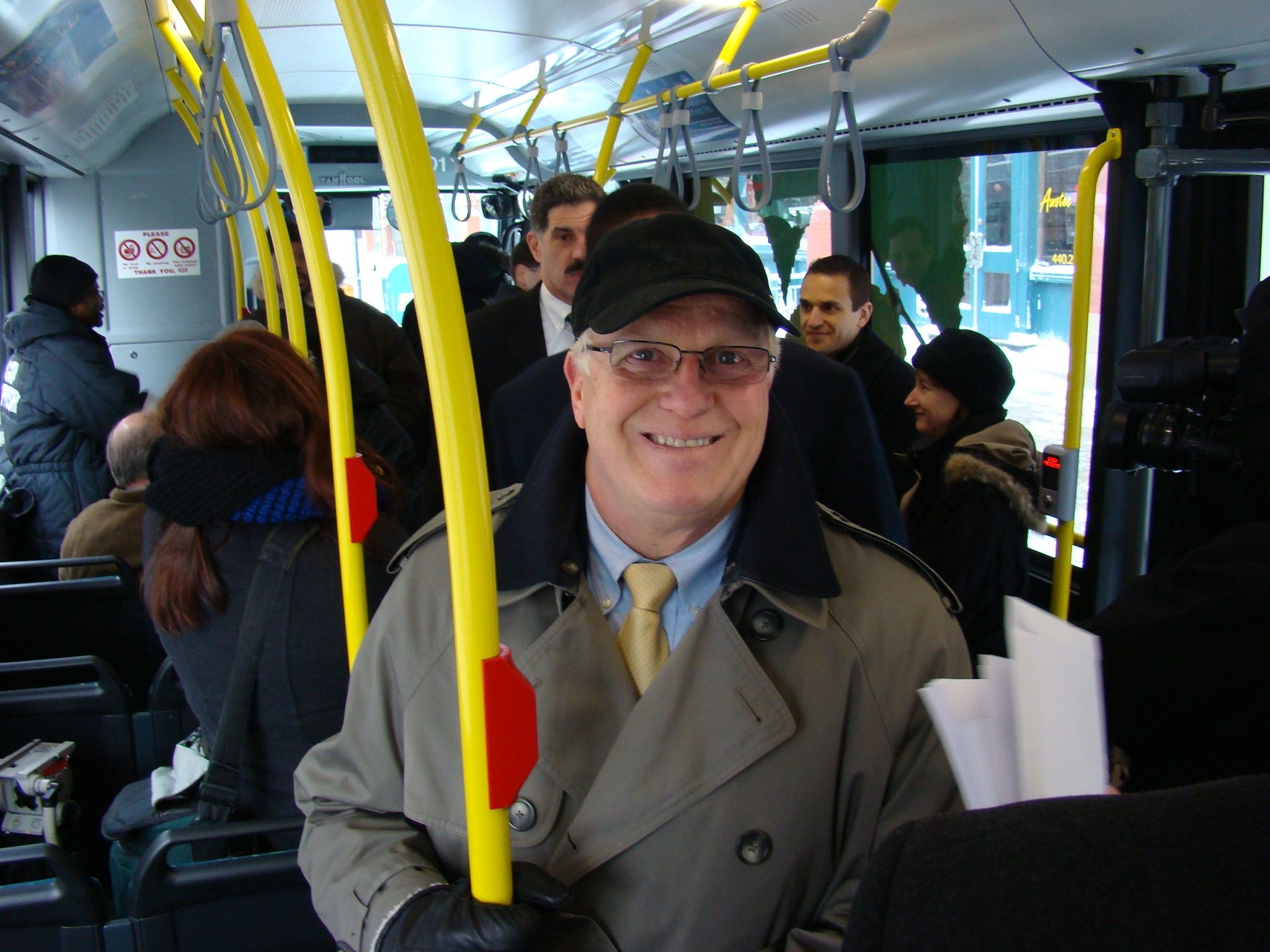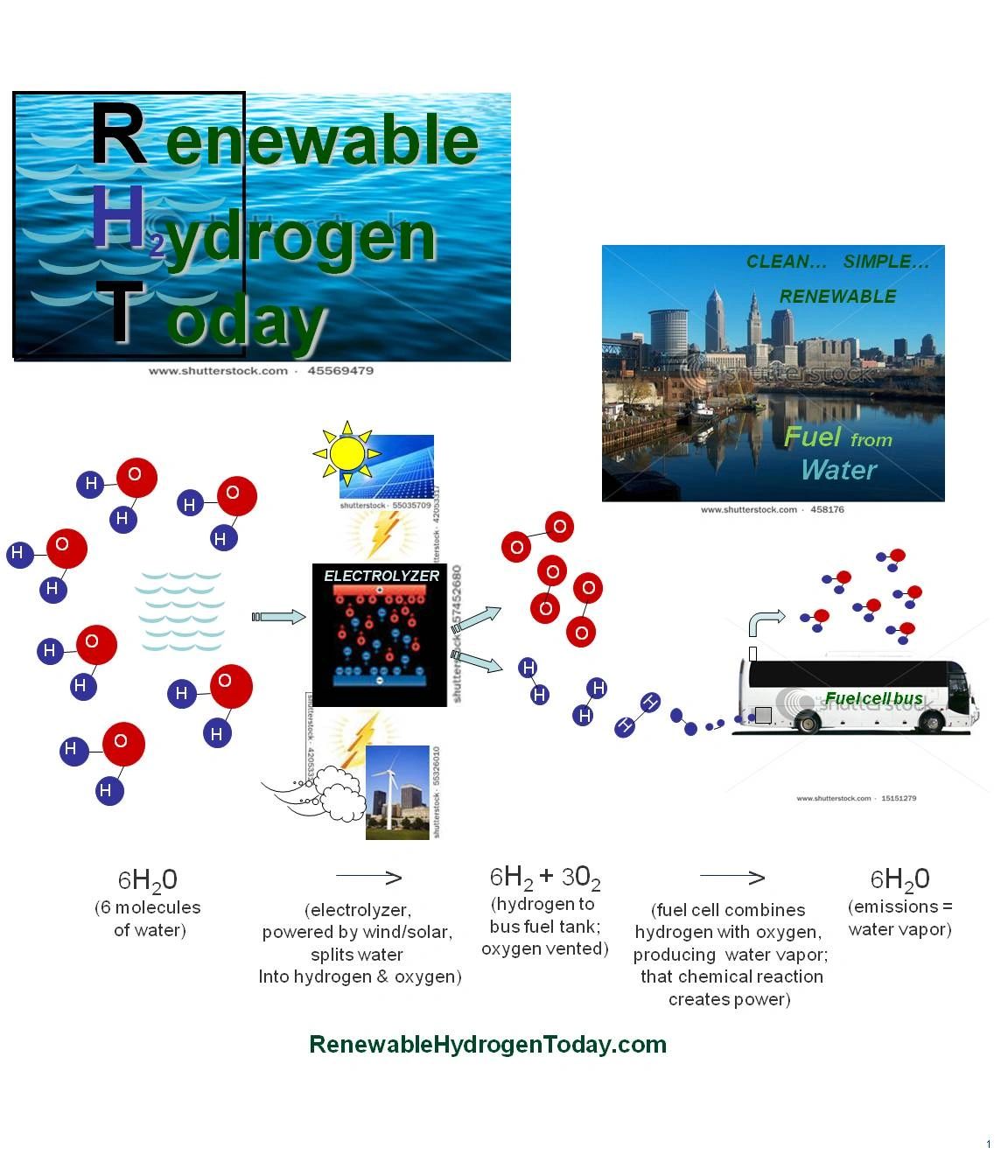Main Navigation
This website shares information about a key technology for our 100% clean energy grid, and the first hydrogen fuel cell program of its kind in Northeast Ohio (NEO) - and the public/private collaborators that planned and implemented an initial project:
A hydrogen fueling station and fuel cell bus pilot project
- within the Greater Cleveland Regional Transit Authority (GCRTA) system
December 2012: GCRTA begins running a fuel cell bus in revenue service on regular daily routes - the first fuel cell bus in NEO. The team successfully demonstrates production, compression and storage of hydrogen. GCRTA successfully fuels, operates and maintains the ClearEdge fuel cell bus.
June 2013: As planned, the pilot project ends. NASA's electrolyzer is returned to them, with station components, and the fuel cell bus is returned and redeployed.
GCRTA continues to support electrolyzer-based hydrogen and fuel cell technologies for sustainable transportation. Renewable Hydrogen Today collaborators look toward further projects - - in mass transportation, passenger vehicles and utility power. These clean techologies can be used to replace nearly any fossil fuel energy application.

(Art and production by Creative Works Inc. ©2013 cre8veworks.com)
PHOTOS: Some team members at GCRTA Hayden before bus (in background) deployed
(below) (photo courtesy of the Naitonal Aeronautics and Space Administration)
Fuel cell bus (photo courtesy of the National Aeronautics and Space Administration)
Joe Calabrese, GCRTA General Manager (photo by Valerie Lyons)



COLLABORATORS:
NASA Glenn Research Center (GRC): GRC was the project lead for the station and bus project as it was ultimately implemented at the GCRTA facility in East Cleveland; and was a central technical leader for eight years as the project concept evolved, drawing from diverse energy expertise resident at this NASA "Center for Propulsion and Power" in Cleveland since the 1940s. Also, NASA Kennedy Space Center loaned an electrolyzer to the project.
Greater Cleveland Regional Transit Authority (GCRTA): Provided eight years of proactive leadership as the project evolved. Originally GCRTA was involved with the planning of the bus operation at the Great Lakes Science Center. Recently, GCRTA provided investment of management and staff for meetings and funding pursuits; internal logistics to plan and implement the station build; training of drivers; maintenance and fueling of the fuel cell bus; compliance with regulations and permitting; revenue service scheduling; etc.
ClearEdge Power (formerly UTC Power), a leading fuel cell technology manufacturer, provided the fuel bus, along with technical expertise and service for the PureMotion 120 fuel cell system. As the project evolved over eight years, ClearEdge Power (formerly UTC Power) had maintained a relationship with the project team and jointly evaluated numerous options to help secure a fuel cell bus as funding opportunities changed. Northeast Ohio's Midwest location with emerging hydrogen-based industries, as well as GCTRA's commitment and strong reputation within the transit industry, enabled this fuel cell bus demonstration project to proceed. (ClearEgde Power has facilities in Connecticut, Oregon and California.)
The Cleveland Foundation (TCF): As an early supporter of this project, TCF provided the original funding of $310K, some of which carried through nearly to project completion. At TCF's suggestion, funding was included for Cleveland State University to develop a "Hydrogen Energy Roadmap" associated with the project. TCF also provided $5K in funding for educational bus panels and on-board literature.
Hydrogen and Fuel Cell Consultants, Inc. (HFCC): Paul Prokopius, President and CEO, is the originator of the project concept, original technical lead, advisor and major contributor for the duration of the project, providing decades of renewable power experience and networks, and both management and field work. (HFCC is located in Brecksville, Ohio.)
Technology Management, Inc. (TMI), located in Cleveland, is a developer of modular, solid oxide fuel cell systems. TMI's CEO, Benson Lee, as a civic leader and board member of The Cleveland Foundation, served as an advisor and networking resource in the renewable energy sector, continually bringing together regional forces to move us forward. These forces are still together in the Renewable Hydrogen Today collaborative.
Future Energy Solutions (FES): For much of the project duration, Erik White, Owner of FES, shared fuel cell technology expertise, designed diagrams, investigated safety and permit concerns, and also led stakeholder meetings via phone. Much of the foundational detailed technical work was provided by Erik White. (FES is located in Mansfield, Connecticut.)
Sierra Lobo: Provided the engineers and technicians for over two years to construct the station, resulting in successful completion, and overcoming technical obstacles along the way. (Sierra Lobo is a regional company founded by engineers, with technical expertise in systems engineering, testing, and advanced technologies - based in Milan, Ohio.)
Midwest Sustainable Solutions (MSS): Linda Sekura (MSS Owner) was the original coordinator of the project, and continues as coordinator of the Renewable Hydrogen Today (RHT) collaboration. During the project's eight year evolution, MSS networked with potential collaborators, assisted technical personnel, researched grants, wrote funding proposals, and led RHT outreach and communications. (MSS is a small Cleveland business, founded to implement green projects.)
Ohio Aerospace Institute (OAI): Acted as fiscal agent for The Cleveland Foundation funds, and spent several years facilitating planning of the logistical steps toward the station construction, networking with collaborators, and in organizing proposals for funding. (OAI is a nonprofit, headquartered in Cleveland, with a mission to increase the aerospace competitiveness of its members and partners: NASA GRC, the Air Force Research Lab at Wright-Patterson Air Force Base, colleges and universities, and companies of all sizes within the aerospace industry.)
Great Lakes Science Center (GLSC): Home of the NASA Glenn Visitor Center, Great Lakes Science Center is providing space for a fuel cell technology and project display. With its location right on Lake Erie, along with its existing wind and solar installations, the Science Center was an inspiring center for planning meetings at the beginning of the project.
City of Cleveland: Formed a regional local government collaboration in order to spread awareness within their facilities about the hydrogen station project, to promote ease of implementation, and to aid in advising the group about permitting and other regulatory matters.
Cleveland State University (CSU) Monte Ahuja College of Business (formerly Nance College of Business) : Developed a “Hydrogen Energy Roadmap” to establish a better understanding of the potential use of hydrogen as an economic driver in Northeast Ohio with the intent of developing a business model for the hydrogen fueling station as part of a clean energy initiative.
University of Toledo: Provided the services of their engineering department and networks - with the intention of researching methods of increasing efficiency of electrolyzers and fuel cells, and to plan classes around these technologies to advance the technology and increase awareness. This also aided in enhancing several proposal submissions.
Parker Hannifin Corporation: Originally offered to provide parts to build a renewably-generated-hydrogen electrolyzer, which was one of the original goals of the project. Parker also provided technical and business advice, and wrote a business model plan for funding proposals. (Parker Hannifin Corporation, the global leader in motion and control technologies, is based in Cleveland.)
Makel Engineering, Inc (MEI): Developed and manufactured the hydrogen sensor that was used in the project (with partners Case Western University and NASA). MEI, based in Chico, California, develops advanced technologies for aviation, aerospace and other commercial applications.
Sustainable Cleveland 2019 "Advanced Energy Generation" Group: Promoted the project as one of their top regional energy goals for success in 2013, and highlighted the project at several of their events. The ongoing Sustainable Cleveland initiative, facilitated by the Mayor's Office of Sustainability, celebrates an aspect of sustainability each year, with 2013 designated the "Year of Advanced and Renewable Energy."
Earth Day Coalition (EDC): Provided space at their annual Earthfest celebration (Ohio's largest Earth Day event) for two annual events, to enhance public awareness of fuel cell vehicles. EDC, a regional sustainability nonprofit since 1990, provided the event space as part of the EDC-led "Northeast Ohio Clean Cities Coalition," one of 100 coalitions designated by the U.S. Department of Energy Clean Cities initiative.
FUEL PROCESS GRAPHIC: Click here for the full-page fuel process graphic, and click here for a station infrastructure graphic. Both pages include additional hydrogen technology information.

(Art and production by Creative Works Inc. ©2013 cre8veworks.com)

Contact Us: Linda Sekura, Midwest Sustainable Solutions: 216-598-0113, LSekura@aol.com
Renewable Hydrogen Today (RHT) collaborative coordinator
Content copyright 2015 Renewable Hydrogen Today. All rights reserved.
